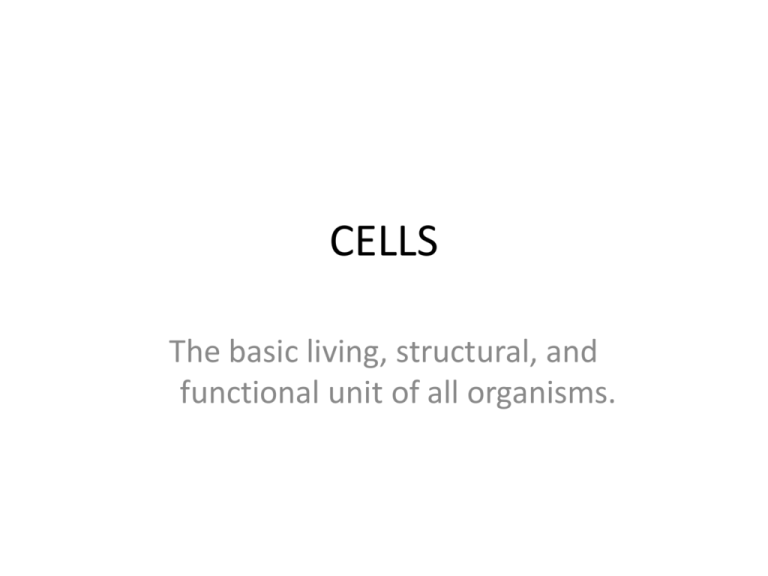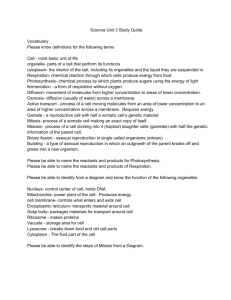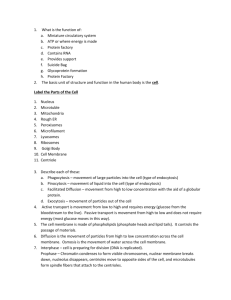CELLS
advertisement

CELLS The basic living, structural, and functional unit of all organisms. Basic Cell Structure • • • • Cell (Plasma) Membrane Cytosol Organelles Nucleus Basic Cell Basic Cell Structures Cytosol • The semi-fluid component of cytoplasm or intracellular fluid • 75% - 95% water • May contain organelles, large carbohydrates, fat, and protein molecules Function of Cytosol • Location of chemical reactions (anaerobic energy metabolism) • Synthesis of cellular substances • Packaging of chemicals for transport • Facilitates excretion of waste material The Cell (Plasma) Membrane • Thin structure that separates the internal cellular components from the external environment. Cell Membrane Structure of the Cell Membrane • • • • Phospholipid bilayer Hydrophilic phosphoric heads face outward Hydrophobic fatty acid tails face inward Carbohydrates assist in cell identification/communication • Cholesterol increases strength of cell membrane Cell Membrane Proteins • Integral Proteins are proteins imbedded in the phospholipid bilayer – gates or channels are transport proteins – receptor sites for hormones – enzymes – cellular identity markers • Peripheral Proteins are loosely bound to plasma membrane – function not completely understood Cell Membrane Structures Cell Membrane Proteins Functions of the Cell Membrane • Flexible boundary • Facilitates contact with other cells and environment • Receptor sites - hormones, enzymes, neurotransmitters, nutrients, antibodies • Selectively permeable - mediates entrance and exit of material into and out of cell. Factors Influencing Permeability of Plasma Membrane • • • • Size of molecules Solubility in lipids Charge on ions Presence of carrier molecules Movement Across the Cell Membrane Intracellular Fluid • Fluid found in living cells • Comprises > 66% of body’s total water • Mostly water – may also contain potassium, phosphates, magnesium, chloride, and other ions The Extracellular Environment • Interstitial Fluid (Intercellular Fluid) – Fluid found in the microscopic spaces between cells • Plasma – Extracellular fluid within blood and lymph vessels Movement Across the Plasma Membrane • Passive Processes – No energy expenditure – Moves down a concentration gradient – High →low concentration • Active Processes – – – – Requires energy expenditure Moves against a concentration gradient Low → high concentration May utilize 40% of cells ATP supply Movement Across the Cell Membrane Passive Transport • • • • • Diffusion Facilitated Diffusion Osmosis Dialysis Filtration Diffusion • The movement of molecules from a higher concentration to a lower concentration. Does not require energy. • Ex: perfume, electrolytes Osmosis Facilitated Diffusion • Facilitated diffusion is the process of diffusion through the protein channels of the cell membrane. • Ex: glucose Facilitated Diffusion Dialysis • Dialysis is the diffusion of small solute particles through a selectively permeable membrane resulting in the separation of large and small solutes. • Example: Kidney dialysis Filtration • Filtration is the process of removing particles from a solution by allowing the liquid to pass through a membrane. It is influenced by gravity and hydrostatic pressure. • Example: Filtration in the glomerulus of the kidney nephron. Active Transport Processes • 1. Endocytosis occurs when the molecules are too big to enter the cell by diffusion or active transport, a vesicle is formed from the cell membrane. • Example: Phagocytosis or cell eating. • 2. Exocytosis • Any remaining particles from phagocytosis may be expelled from the cell when the vesicle joins with the cell membrane and the contents are removed from the cell. Active Transport • Active Transport – Uses energy – Ions move against a concentration gradient • Na+/K+ pump – Estimated 40% ATP use in the body • Cytosis (Bulk Transport) – Endocytosis • Phagocytosis - cell eating • Pinocytosis - cell drinking • Receptor mediated endocytosis – Exocytosis Na+/K+ Pump Effects of Osmosis • Isotonic Solutions • Hypotonic Solutions • Hypertonic Solutions Tonic Solutions Nucleus • • • • The “control center” of the cell Usually the largest structure in the cell Contains genetic information Controls cellular function and structure Nuclear Structures • Nuclear Membrane • Nucleoplasm • Nucleolus – site of ribosome synthesis • Genetic Material DNA – Chromatin contains DNA in thread-like form (cell is not dividing) – Chromosomes contains DNA in short, rod-like structures (cell is reproducing) Cell Nucleus Organelles • Specialized structures and portions of the cell with characteristic shapes that assume specific roles: – growth – repair – maintenance – control of cellular functions Organelles and Structures • • • • • • • • • Ribosomes Endoplasmic Reticulum Golgi Complex Mitochondria Lysosomes Vacuoles Peroxisomes Microfilaments Microtubules Organelles and Structures, cont • • • • • Centrioles Centrosomes Flagella Cilia Microvilli Ribosomes • Appear as small, round, granular structures within the cell • Sites of protein synthesis by assembling the amino acids in the correct order. • Made up of special type of RNA called ribosomal RNA (rRNA) Ribosomes Endoplasmic Reticulum • Double membranous channels which are continuous with the nuclear membrane • Granular (Rough) Endoplasmic Reticulum – studded with ribosomes – site of protein synthesis • Agranular (Smooth) Endoplasmic Reticulum – free of ribosomes – site of lipid synthesis Functions of Endoplasmic Reticulum • • • • • • • Mechanical support and distribution of cytoplasm Surface area for chemical reactions Intracellular transport system Storage of synthesized molecules Protein (RER) and lipid (SER) synthesis Detoxification of certain molecules Release of calcium ions in muscles Endoplasmic Reticulum Golgi Complex (Bodies) • Flattened membranous sacs (4 - 8) stacked upon one another • Processes, packages, sorts, and delivers proteins to various parts of the cell • Secretion of lipid molecules from the cell Golgi Complex Mitochondria • Powerhouse of the cell • Small, spherical or rod-shaped structures • Sites of cellular respiration – conversion of glucose and lipids to ATP – aerobic energy metabolism Mitochondria Lysosomes • Nicknamed “suicide packets” • Small membrane enclosed spheres of digestive enzymes • Intracellular digestion – Autophagy is the process by which old worn out organelles are digested – Autolysis is the process by which lysosomes digest themselves Lysosomes Vacuoles • Fluid filled organelles enclosed by a membrane • Used to store digested cellular food or water Peroxisomes • Similar to lysosomes but much smaller • Usually found in the liver and kidney • Must have metabolic oxygen present to function properly • Role in detoxifying molecules (alcohol) The Cytoskeleton • Complex internal structure of cytoplasm that consists of small lattice-like or web-like structures • Provides support and maintains shape of the cell • Provides organization for chemical reactions • Assists in transport of substances through the cytosol Cytoskeleton Structures Structures of the Cytoskeleton • Microfilaments are rod-like, variable length - Actin and Myosin in muscles • Microtubules are straight cylindrical structures • Intermediate Filaments provide structural support and framework • Microfilaments, Microtubules, and Intermediate Filaments make up the Microtrabecular Lattice Centrioles A pair of cylindrical structures located within the centrosome which serves as center of chromosome movement during cell division (mitosis) Centrosomes Dense area of spherical cytoplasm generally located near the nucleus Centrosomes/Centrioles Modifications of the Plasma Membrane • Microvilli – folds in the cell membrane – increase surface area for absorption of nutrients • Cilia – slender projections of the cell membrane – move substances across surface of the cell • Flagellum – single whip-like projection – used for cellular locomotion Flagellum/Cilium Cell Division • Process by which cells reproduce themselves • Results in increased number of cells or HYPERPLASIA • Nuclear Division – Somatic cell nuclear division (MITOSIS) – Sex cell nuclear division (MEIOSIS) • Cytoplasmic Division - Cytokinesis Mitosis Overview Results of Mitosis Formation of two new daughter cells with identical genetic make up of parent cell Interphase • • • • metabolic phase - between cell division replication of chromosomes replication of centrioles time - highly variable from: – non existent – years • normally about 18 to 24 hours Stages of Mitosis • Prophase – First part of cell division – Centrioles migrate to the poles to direct assembly of mitotic spindle fibers – DNA appears as double-stranded chromosomes – Nuclear envelope breaks down and disappears Stages of Mitosis • Metaphase – Chromosomes are aligned in the center of the cell on the metaphase plate Stages of Mitosis • Anaphase – Chromosomes are pulled apart and toward the opposite ends of the cell – Cell begins to elongate Stages of Mitosis • Telophase – Chromosomes uncoil to become chromatin – Nuclear envelope reforms around chromatin – Spindles break down and disappear Stages of Mitosis • Cytokinesis – Begins during late anaphase and completes during telophase – A cleavage furrow forms to pinch the cells into two parts Centrioles Plasma membrane Interphase Chromatin Nuclear envelope Nucleolus Figure 3.15, step 1 Centrioles Forming mitotic spindle Centromere Chromosome, consisting of two sister chromatids Early prophase Figure 3.15, step 2 Spindle microtubules Centromere Fragments of nuclear envelope Spindle pole Late prophase Figure 3.15, step 3 Metaphase plate Spindle Sister chromatids Metaphase Figure 3.15, step 4 Daughter chromosomes Anaphase Figure 3.15, step 5 Nucleolus forming Cleavage furrow Nuclear envelope forming Telophase and cytokinesis Figure 3.15, step 6 Centrioles Chromatin Centrioles Forming mitotic spindle Plasma membrane Nuclear envelope Nucleolus Interphase Chromosome, consisting of two sister chromatids Early prophase Metaphase plate Spindle microtubules Centromere Centromere Fragments of nuclear envelope Spindle pole Late prophase Nucleolus forming Cleavage furrow Spindle Metaphase Sister chromatids Daughter chromosomes Anaphase Nuclear envelope forming Telophase and cytokinesis Figure 3.15 Cytokinesis division of the cytoplasm Meiosis • mechanism by which sperm and egg cells are produced • results in the production of sex cells GAMETES – Ovary ---> Oogenesis ---> Ovum – Testes ---> Spermatogenesis ---> Sperm • union and fusion of gametes is called fertilization • cell produced by fertilization - Zygote









